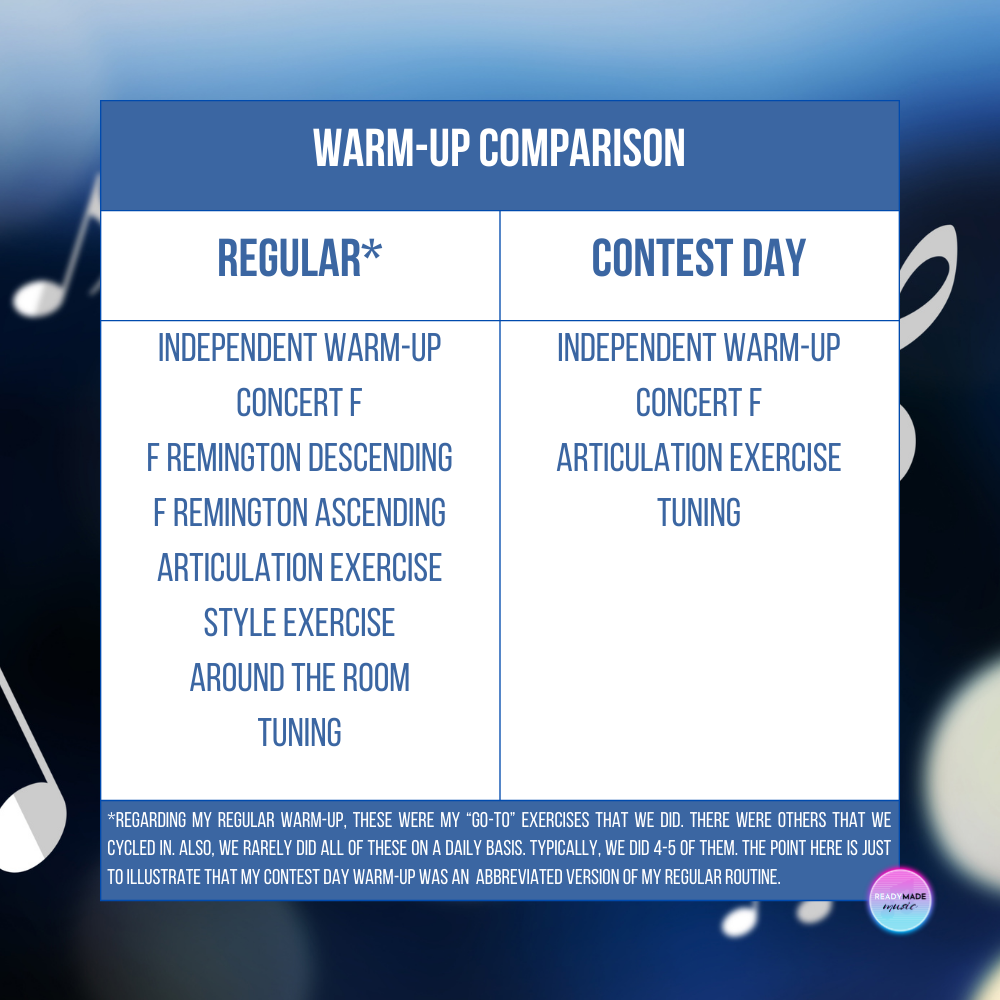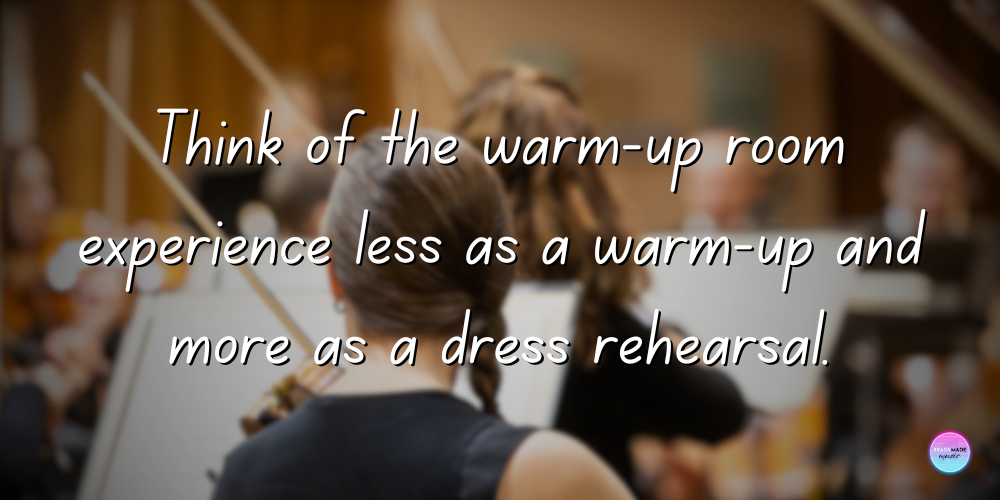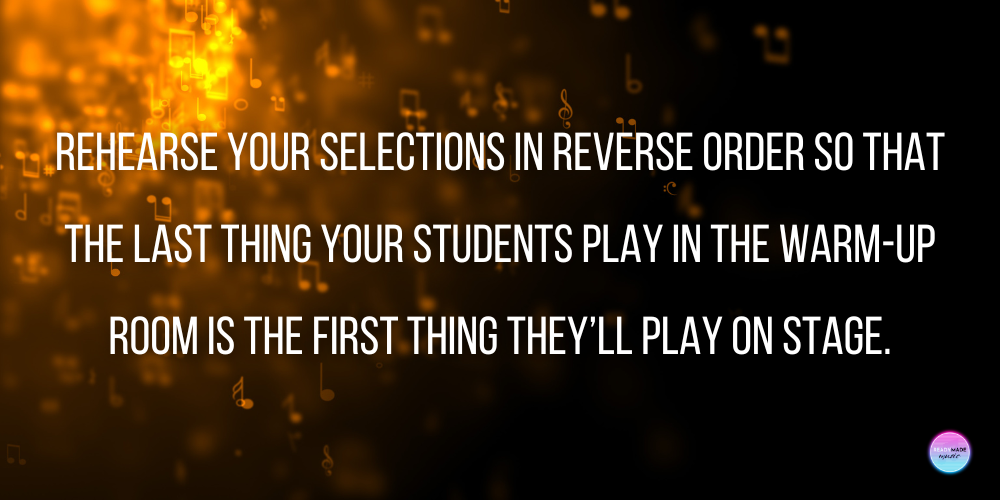10 Tips to Make the Most of Your Contest Warm-up
Mar 01, 2025
Estimated Read Time: 5-7 minutes
By Rob Chilton
Most contests and festivals allow ensembles a 20-30 minute warm-up before taking the stage. In my early years as a band director, I often struggled to use this time efficiently. I frequently left warm-up feeling like I could have done more to prepare my students. Based on those experiences, I’ve compiled 10 tips to help you make the most of your warm-up time.
#1: Avoid Anything New
This may go without saying, but avoid introducing anything new! Your warm-up routine should be familiar and designed to promote focus and build confidence. Changing things up—such as having the ensemble play a warm-up exercise from a conducted beat when they’ve only ever used a metronome—can be unsettling during these crucial moments before a performance.

#2: Limit Metronome Use
If you regularly use a metronome during warm-ups, incorporate it in the warm-up room as well–either by using the device itself or clapping/snapping the tempo. Beyond that, avoid relying on it while rehearsing your music, except to check tempos. Since your students will perform without a metronome on stage, the warm-up room should simulate that experience.
#3: Reduce the Quantity of Warm-up Exercises
Consider reducing your warm-up exercise routine to just one or two exercises so you can get to the literature faster. Think of the warm-up room less as a warm-up and more as a dress rehearsal. Here’s a chart of what my regular warm-up versus my contest warm-up might be:

That said, for younger students–especially those in middle school non-varsity groups–I recommend a slightly longer warm-up that includes one or two familiar exercises, such as long tones or a Remington exercise, to establish routine and help them focus. Regardless of your approach, the goal is to help them quickly acclimate to the new environment and transition to music.

#4: Review Starts & Transitions
A rough start to a piece can throw everything off. In the warm-up room, rehearse the beginning of each selection two or three times, playing just the first 8–16 measures before stopping and restarting. It’s also helpful to review major transitions, such as tempo and key changes, as these are common trouble spots.
#5: Let Your Soloists Play
When possible, provide your soloists a chance to play their solo passages in context with the group during this time. This is especially important for young and less experienced soloists like those in middle school or junior high groups. Speaking from my own experience as a young oboist who played many solos growing up, giving your soloists a chance to play in the warm-up room can significantly reduce their performance anxiety.
Check out our music literacy method!
#6: Rehearse in Reverse Order
In the warm-up room, I often rehearse our performance selections in reverse order. For example, if we're performing three pieces, we’ll start with the closer, then the middle piece, and finish with the opener. This way, the last thing we play in the warm-up room is the first thing we’ll perform on stage.

#7: Provide Independent Practice Minutes
Between selections, give your students a minute of independent practice. Offer clear instructions, encouraging them to review any section they want to revisit before going on stage. This approach is effective because you often won’t have time to run the entire program in the warm-up room, and this allows everyone to address their own areas of concern. When using this strategy, I typically say:

#8: “Let Your Mistakes Out in the Warm-up”
I used to play oboe in the Lone Star Wind Orchestra, a Dallas-based wind band led by renowned conductor Eugene Corporon. Something he said to me during a pre-concert warm-up made an impression on me. I was making mistakes in a solo passage that I had not previously made, and in response, Mr. Corporon said to me, “Let your mistakes out in the warm-up.” His words suggested that by releasing my errors beforehand, we were setting them free–keeping them from appearing on stage. Of course, this isn’t entirely true, but as a player, I found his words comforting—and as a director, I’ve seen this phrase do the same for my students.

#9: Beware of The Warm-up Room Phenomenon
It always seemed my groups sounded worse in the warm-up room than they did back on our home campus. Small technical errors, missed key signatures and accidents, and tuning issues seemed to be more abundant. After the fact, I would often ask my coworkers if my ensemble sounded worse to them that day while in the warm-up room. Their response was almost always that they didn’t–they played about the same as they always did.
I eventually realized that my group wasn’t playing worse, but rather, I was experiencing heightened awareness as a stress response to the approaching performance. This increased sensitivity allowed me to hear with greater acuity, making errors seem more frequent and intensifying my reaction to them. This heightened experience is what I call the Warm-up Room Phenomenon. The best way to manage it is to stay calm and remind yourself that what you’re hearing isn’t likely as intense as it seems.

#10: Expect the Unexpected
Finally, expect the unexpected. Sometimes, it’s as simple as random performance errors. Other times, it’s more serious, such as an instrument breaking, or a student suddenly falling ill. I once had my clarinet soloist vomit in the warm-up room just minutes before we took the stage. Things happen—anticipate surprises, and you’ll be better prepared to handle them when they come.

Final Advice
In the days and weeks leading up to the contest, prepare your students by simulating the warm-up room experience on your home campus. Remember Tip #1: Avoid anything new! Describe the setting, outline the routine, set clear expectations, and practice your contest day warm-up. Doing this will help them stay calm and organized when the day comes for them to take the stage for their big performance!
Thanks to Tiffany Lisko of Dowell Middle School in McKinney, Texas for suggesting this topic!
Related post:
Never miss a new posting!
Check out this short video!
About the author:

Rob Chilton is the creator and owner of Readymade Music, LLC and its content. Previously, Chilton was a middle school band director from 2007-2021. His most recent teaching position was the Head Band Director at Killian Middle School in Lewisville, Texas from 2014-2021.
Under his direction, the Killian Honors Band was named the 2018 Texas Music Educators Association CC Honor Band and performed at the annual 2018 TMEA Clinic/Convention. In 2019, the Killian Honors Band was invited to and performed at The Midwest Clinic in Chicago. Additionally, the Killian Honors Band was named a National Winner in the Mark of Excellence National Wind Band Honors Project in 2015, 2016, 2017, 2018, and 2019.
Chilton is a graduate of Southern Methodist University where he had the opportunity to study music education under the tutelage of Lynne Jackson and Brian Merrill. During his years as a middle school band director, Chilton continued his professional growth under the guidance of his primary clinicians, John Benzer and Brian Merrill.
Chilton’s mission for Readymade Music is to promote the overall well-being of music education and support school music teachers by providing solutions to help make teaching music more efficient and inspirational while increasing engagement for 21st century learners.

© 2025 Readymade Music, LLC
All rights reserved.
The unauthorized distribution and/or reproduction of this work is illegal.





